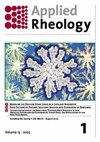使用实验室装置自动表征非牛顿流体
IF 5.8
4区 工程技术
Q1 MECHANICS
引用次数: 3
摘要
摘要为了在减少人为干预的情况下提高钻井效率,近年来人们一直在追求钻井液性质测量的自动化。充分监测和调节钻井液的密度和流变性是泥浆工程师的基本职责。在本研究中,进行了自动表征流体的实验测试。基本目标是测量沿管道两段的压差:一段是水平段,一段是垂直段。利用这些测量数据,然后提出数学算法来估计流体的密度,然后根据流动形式、层流和湍流估计流体的粘度。结果与旋转流变仪的测量值进行了比较和验证。借助模型和数值格式,本文的工作为提高流体性质连续测量和监测的准确度和精度提供了良好的机会。本文章由计算机程序翻译,如有差异,请以英文原文为准。
Automated Characterization of Non-Newtonian Fluids Using Laboratory Setup
Abstract The automation towards drilling fluid properties’ measurement has been pursued in the recent years in order to increase drilling efficiency with less human intervention. Adequately monitoring and adjusting density and rheology of drilling fluids are fundamental responsibilities of mud engineers. In this study, experimental tests that automatically characterize fluids were conducted. The basic objective is to measure the differential pressures along two sections of the pipes: one horizontal section and one vertical section. Using such measuring data, mathematical algorithms are then proposed to estimate fluids’ density and subsequently viscosity with respect to flow regimes, laminar and turbulence. The results were compared and validated with the values measured on rotational rheometers. With the help of models and numerical schemes, the work presented in the paper reveals a good opportunity to improve the accuracy and precision of continuous-measuring and monitoring fluids’ properties.
求助全文
通过发布文献求助,成功后即可免费获取论文全文。
去求助
来源期刊

Applied Rheology
物理-力学
CiteScore
3.00
自引率
5.60%
发文量
7
审稿时长
>12 weeks
期刊介绍:
Applied Rheology is a peer-reviewed, open access, electronic journal devoted to the publication in the field of applied rheology. The journal provides the readers with free, instant, and permanent access to all content worldwide; and the authors with extensive promotion of published articles, long-time preservation, language-correction services, no space constraints and immediate publication.
 求助内容:
求助内容: 应助结果提醒方式:
应助结果提醒方式:


